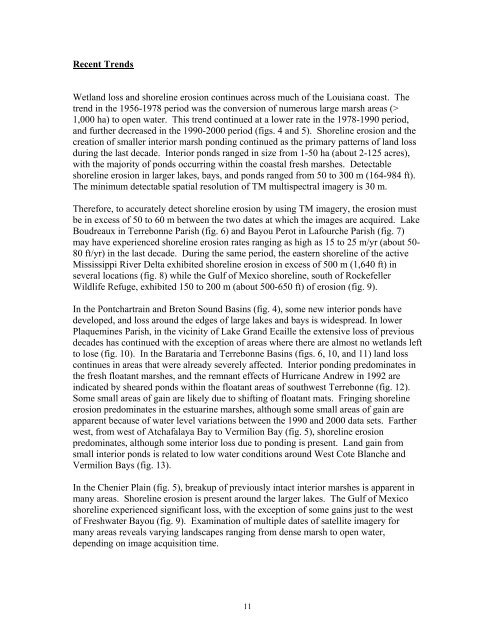Historical and Projected Coastal Louisiana Land Changes
Historical and Projected Coastal Louisiana Land Changes
Historical and Projected Coastal Louisiana Land Changes
You also want an ePaper? Increase the reach of your titles
YUMPU automatically turns print PDFs into web optimized ePapers that Google loves.
Recent Trends<br />
Wetl<strong>and</strong> loss <strong>and</strong> shoreline erosion continues across much of the <strong>Louisiana</strong> coast. The<br />
trend in the 1956-1978 period was the conversion of numerous large marsh areas (><br />
1,000 ha) to open water. This trend continued at a lower rate in the 1978-1990 period,<br />
<strong>and</strong> further decreased in the 1990-2000 period (figs. 4 <strong>and</strong> 5). Shoreline erosion <strong>and</strong> the<br />
creation of smaller interior marsh ponding continued as the primary patterns of l<strong>and</strong> loss<br />
during the last decade. Interior ponds ranged in size from 1-50 ha (about 2-125 acres),<br />
with the majority of ponds occurring within the coastal fresh marshes. Detectable<br />
shoreline erosion in larger lakes, bays, <strong>and</strong> ponds ranged from 50 to 300 m (164-984 ft).<br />
The minimum detectable spatial resolution of TM multispectral imagery is 30 m.<br />
Therefore, to accurately detect shoreline erosion by using TM imagery, the erosion must<br />
be in excess of 50 to 60 m between the two dates at which the images are acquired. Lake<br />
Boudreaux in Terrebonne Parish (fig. 6) <strong>and</strong> Bayou Perot in Lafourche Parish (fig. 7)<br />
may have experienced shoreline erosion rates ranging as high as 15 to 25 m/yr (about 50-<br />
80 ft/yr) in the last decade. During the same period, the eastern shoreline of the active<br />
Mississippi River Delta exhibited shoreline erosion in excess of 500 m (1,640 ft) in<br />
several locations (fig. 8) while the Gulf of Mexico shoreline, south of Rockefeller<br />
Wildlife Refuge, exhibited 150 to 200 m (about 500-650 ft) of erosion (fig. 9).<br />
In the Pontchartrain <strong>and</strong> Breton Sound Basins (fig. 4), some new interior ponds have<br />
developed, <strong>and</strong> loss around the edges of large lakes <strong>and</strong> bays is widespread. In lower<br />
Plaquemines Parish, in the vicinity of Lake Gr<strong>and</strong> Ecaille the extensive loss of previous<br />
decades has continued with the exception of areas where there are almost no wetl<strong>and</strong>s left<br />
to lose (fig. 10). In the Barataria <strong>and</strong> Terrebonne Basins (figs. 6, 10, <strong>and</strong> 11) l<strong>and</strong> loss<br />
continues in areas that were already severely affected. Interior ponding predominates in<br />
the fresh floatant marshes, <strong>and</strong> the remnant effects of Hurricane Andrew in 1992 are<br />
indicated by sheared ponds within the floatant areas of southwest Terrebonne (fig. 12).<br />
Some small areas of gain are likely due to shifting of floatant mats. Fringing shoreline<br />
erosion predominates in the estuarine marshes, although some small areas of gain are<br />
apparent because of water level variations between the 1990 <strong>and</strong> 2000 data sets. Farther<br />
west, from west of Atchafalaya Bay to Vermilion Bay (fig. 5), shoreline erosion<br />
predominates, although some interior loss due to ponding is present. L<strong>and</strong> gain from<br />
small interior ponds is related to low water conditions around West Cote Blanche <strong>and</strong><br />
Vermilion Bays (fig. 13).<br />
In the Chenier Plain (fig. 5), breakup of previously intact interior marshes is apparent in<br />
many areas. Shoreline erosion is present around the larger lakes. The Gulf of Mexico<br />
shoreline experienced significant loss, with the exception of some gains just to the west<br />
of Freshwater Bayou (fig. 9). Examination of multiple dates of satellite imagery for<br />
many areas reveals varying l<strong>and</strong>scapes ranging from dense marsh to open water,<br />
depending on image acquisition time.<br />
11

















